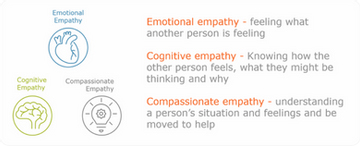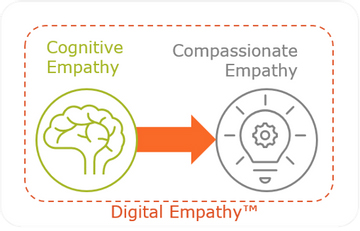Delivering empathy at scale was seen as ‘too hard’ – often meaning that the customer experience was dictated by operational needs.
Empathy is a hot topic in business right now: a query via your favourite search engine on empathy and business will yield tens of millions of results. Many organisations have now declared it the new competitive battleground and the natural evolution of Customer Experience (CX).
by Peter Dorrington
Research shows: empathy is the biggest driver of loyalty. With more interactions happening digitally, it has become harder to understand the emotions created by your operations, yet your customers still expect you to understand how they feel. Yet many companies are still primarily focused on driving operational improvement, reducing effort, and removing friction which has resulted in them unwittingly engineering out relationships with their customers; the cost of lower friction may have been a loss of traction.
Executives have also recognised that in the online world, commoditisation is inevitable (driven by the need to be found by search engines using common terms or rankings on comparison websites). However, in a commoditised market, it is not the product or service that is the differentiator; it’s the way that customers feel about the experience overall, and what customers want to feel is compassion – being understood and valued as humans, not case numbers.
Competence is not a differentiator – competence with compassion is.
Customer Experience is not new – the principles (if not the name) were laid down in the middle of the last century, but it really took off as a discipline after Robert Woodruff published his paper ‘Customer value: The next source for competitive advantage’ in 1997. Now, nearly 25 years later, most organisations have some form of CX program in place, but the low-hanging fruit has all been picked – all the easy tasks have been done; hence the interest in empathy – the next opportunity for deepening customer engagement.
Just like CX, corporate discussions about empathy are not new either but in the industrial era of mass-production / mass-marketing (i.e. pre-commoditisation) the discussion was all about the features of the product and how they benefited customers. At that point, it felt like only the advertising department cared about how customers felt, everyone else was busying themselves making better ‘stuff’. Most executives at the time thought that empathy was just ‘being nice to people’ and probably would cost a lot of money to implement in any practical way.
Empathy is the ability to understand another person’s thoughts and feelings from their point of view
So what constitutes empathy? I define empathy as having three main components:

Over the last decade or so, a lot of attention has been focussed on training Emotional Intelligence (EQ) for frontline staff – techniques that include and bring together a basic understanding of what the customer is feeling, with an understanding of what the employee is feeling and using that to tailor the conversation – to establish rapport. The focus at this point was on use of language and ‘in the moment’ prompts for next best action or analysing conversations to support employee training.
However, reliance on EQ training for frontline staff as your primary model of delivering empathy does has a significant drawback – it only works during a human-to-human interaction, for example, during a customer service call. EQ training for staff does little to improve all the non-human-led interactions – mobile, digital, automated, self-service transactions, etc. and so much of the attention has been about process excellence – making the process simple and easy. Delivering empathy at scale, across all channels and consistently was seen as ‘too hard’.
As a result of the pandemic, many businesses had to move much of their operations into digital delivery, often with the result that the customer experience was dictated by operational needs. Now as the recovery begins, much of that digital investment will need to evolve and play a growing role in ongoing day-to-day customer interactions. The ‘Dash to Digital’ has become the ‘Race to Recovery’ and that race is a marathon, not a sprint.
So how do we rebuild the empathetic core of customer experience management? At Anthrolytics, we do this by what we call Digital Empathy™ and it is powered by Predictive Behavioural Analytics™ – designed to deliver empathy at scale, at pace, and in a pragmatic way (better, but not perfect).
Until now, ‘digital empathy’ has been a design approach – informing the ways the user experience and processes are designed (the core of human-centric design) but it is still at heart ’empathy as a process’. Our approach is much closer to the thinking behind hyper-personalisation; where personalisation (what we know about a customer) meets real-time customisation (based on what they are trying to do and why).
 The cognitive empathy component is delivered by using data gathered from a mix of sources and Anthrolytics’ Predictive Behavioural Analytics™ – in essence, predicting what an individual customer is feeling, why, and what they are likely to do next.
The cognitive empathy component is delivered by using data gathered from a mix of sources and Anthrolytics’ Predictive Behavioural Analytics™ – in essence, predicting what an individual customer is feeling, why, and what they are likely to do next.
These behavioural insights are then used in operational environments to do a range of tasks: journey orchestration, campaign management, enable process automation (RPA/RDA), and so on. The difference comes in that these decisions and actions are partly informed by how the customer is feeling as well as what they functionally need.
For example, a mobile marketing campaign may be aimed at a segment of customers who meet the qualifying criteria, but some customers are offered a different treatment because they are more likely to respond to that one than the ‘stock’ campaign. In a call centre, in-bound calls from customers who are likely to be emotionally charged can be routed to more experienced agents with higher EQ, whilst day-to-day calls are routed to normal agents.
To the customer, it feels like the organisation is more human – more in tune with their daily lives; they get fewer poorly timed marketing messages, the offers they do get resonate with them better and that the organisation is doing a better job of listening and anticipating what they want, when and how they want it.
Treat customers the way they want to be treated themselves.
One final point, when an organisation gets it right, it impacts business results in a very real, quantifiable way: higher CLTV, lower costs, lower churn, and improve stakeholder engagement. In short, Digital Empathy is one way of putting compassion on the bottom line (more about which I will discuss in an upcoming article).
Peter Dorrington is Co-Founder & Chief Strategy Officer at Anthrolytics. Peter is the inventor of Predictive Behavioural Analytics and a thought leader in the area of Customer and Employee Experience Management. Peter has spent many years as an expert in the field of analytics related to customer and employee experience and is also a renowned speaker on the topic of CX/EX and the experience economy.
This article originally appeared in Anthrolytics. Photo by Ayo Ogunseinde on Unsplash.













